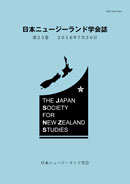Volume 11
Displaying 1-20 of 20 articles from this issue
- |<
- <
- 1
- >
- >|
-
Article type: Cover
2004Volume 11 Pages Cover1-
Published: June 19, 2004
Released on J-STAGE: April 15, 2017
Download PDF (28K) -
Article type: Cover
2004Volume 11 Pages Cover2-
Published: June 19, 2004
Released on J-STAGE: April 15, 2017
Download PDF (28K) -
Article type: Article
2004Volume 11 Pages 1-
Published: June 19, 2004
Released on J-STAGE: April 15, 2017
Download PDF (150K) -
Article type: Article
2004Volume 11 Pages 2-4
Published: June 19, 2004
Released on J-STAGE: April 15, 2017
Download PDF (299K) -
Article type: Article
2004Volume 11 Pages 5-17
Published: June 19, 2004
Released on J-STAGE: April 15, 2017
Download PDF (1112K) -
Article type: Article
2004Volume 11 Pages 18-27
Published: June 19, 2004
Released on J-STAGE: April 15, 2017
Download PDF (1016K) -
Article type: Article
2004Volume 11 Pages 28-34
Published: June 19, 2004
Released on J-STAGE: April 15, 2017
Download PDF (481K) -
Article type: Article
2004Volume 11 Pages 35-41
Published: June 19, 2004
Released on J-STAGE: April 15, 2017
Download PDF (545K) -
Article type: Article
2004Volume 11 Pages 42-45
Published: June 19, 2004
Released on J-STAGE: April 15, 2017
Download PDF (405K) -
Article type: Article
2004Volume 11 Pages 46-50
Published: June 19, 2004
Released on J-STAGE: April 15, 2017
Download PDF (837K) -
Article type: Article
2004Volume 11 Pages 51-53
Published: June 19, 2004
Released on J-STAGE: April 15, 2017
Download PDF (236K) -
Article type: Article
2004Volume 11 Pages 54-55
Published: June 19, 2004
Released on J-STAGE: April 15, 2017
Download PDF (233K) -
Article type: Appendix
2004Volume 11 Pages 56-
Published: June 19, 2004
Released on J-STAGE: April 15, 2017
Download PDF (9K) -
Article type: Appendix
2004Volume 11 Pages 57-
Published: June 19, 2004
Released on J-STAGE: April 15, 2017
Download PDF (42K) -
Article type: Index
2004Volume 11 Pages 58-67
Published: June 19, 2004
Released on J-STAGE: April 15, 2017
Download PDF (251K) -
Article type: Appendix
2004Volume 11 Pages 68-
Published: June 19, 2004
Released on J-STAGE: April 15, 2017
Download PDF (59K) -
Article type: Appendix
2004Volume 11 Pages 69-
Published: June 19, 2004
Released on J-STAGE: April 15, 2017
Download PDF (18K) -
Article type: Appendix
2004Volume 11 Pages 70-
Published: June 19, 2004
Released on J-STAGE: April 15, 2017
Download PDF (10K) -
Article type: Cover
2004Volume 11 Pages Cover3-
Published: June 19, 2004
Released on J-STAGE: April 15, 2017
Download PDF (32K) -
Article type: Cover
2004Volume 11 Pages Cover4-
Published: June 19, 2004
Released on J-STAGE: April 15, 2017
Download PDF (32K)
- |<
- <
- 1
- >
- >|
